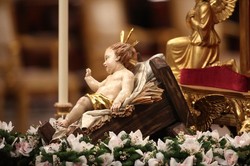Earlier today
the Paul VI Audience Hall was the setting for lunch with 250 of Rome’s
economically and socially challenged people with Pope Benedict XVI. For him, it
was an opportunity to meet Christ in brothers and sisters. The world, of
course, is more interested in knowing what the papal guests ate. The newswires
report that lasagna, veal and cake were on the menu. The Pope’s friends for
lunch are people who interface on a daily basis with the Missionaries of
Charity, the group of sisters founded by Blessed Mother Teresa of Calcutta.
Blessed Teresa’s 100th birthday is this year and the Pope wanted to acknowledge
the greatness of the woman who focused our attention to those most loved by God
and despised by the world.
Dear friends,
I’m very happy to be here today with
you, and I extend warm greetings to the Reverend Mother General of the
Missionaries of Charity, to the priests, sisters, contemplative brothers and
all of you here to enjoy this brotherly moment together.
Continue reading Pope Benedict lunches with Rome’s poor, marks Mother Teresa’s 100th birthday











